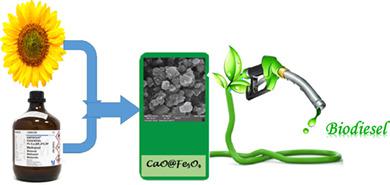当前位置:
X-MOL 学术
›
Environ. Prog. Sustain. Energy
›
论文详情
Our official English website, www.x-mol.net, welcomes your feedback! (Note: you will need to create a separate account there.)
A comparative study on physicochemical properties of two nanomagnetic compounds CaO@Fe3O4 and Fe3O4@CaO and their catalytic role on biodiesel preparation
Environmental Progress & Sustainable Energy ( IF 2.8 ) Pub Date : 2020-01-09 , DOI: 10.1002/ep.13395 Hamid Reza Mardani 1 , Mehdi Forouzani 1 , Nazanin Moradi 1 , Zahra Kheibarian 1
Environmental Progress & Sustainable Energy ( IF 2.8 ) Pub Date : 2020-01-09 , DOI: 10.1002/ep.13395 Hamid Reza Mardani 1 , Mehdi Forouzani 1 , Nazanin Moradi 1 , Zahra Kheibarian 1
Affiliation

|
In this study, two nanomagnetic compounds from calcium oxide and iron (II, III) oxide (CaO@ Fe3O4 and Fe3O4@CaO) were synthesized by hydrothermal method and were characterized by general techniques such as Fourier transform infrared spectroscopy, X‐ray diffraction, field emission scanning electron microscopy, energy dispersive spectroscopy, MAP, and Brunauer–Emmett–Teller. The chemical and physical properties of these nanocompounds were studied, and they were compared with each other. The type of metal oxide as a support part was considered to be very interesting in this research. By changing the support from Fe3O4 to CaO: (a) the crystal size decreased from 41.60 to 36.82 nm, (b) the morphology was significantly changed, CaO@ Fe3O4 got a misty mountain‐like shape but other compound got a tiny spherical shape, (c) surface area and pore volume decreased as CaO@Fe3O4 is macroporous and the other compound is microporous. (d) Fe3O4 as support yielded better results than CaO due to more amount of coating. Both nanomagnetic compounds efficiently performed transesterification process using sunflower oil and methanol without any additional base compounds but CaO@Fe3O4 is slightly stronger catalyst than Fe3O4@CaO. Prepared biodiesel was characterized by nuclear magnetic resonance (1H NMR), 13C‐NMR, and gas chromatography apparatuses. These results also corresponded with the prepared biodiesel by NaOH as a standard.
中文翻译:

两种纳米磁性化合物CaO @ Fe3O4和Fe3O4 @ CaO的理化性质比较及其对生物柴油制备的催化作用
在这项研究中,来自氧化钙和铁2种纳米磁性化合物(II,III)氧化物(CaO的@的Fe 3 ö 4和Fe 3 ö 4 @CaO)通过水热法合成,其结构经一般的技术如傅里叶变换红外光谱,X射线衍射,场发射扫描电子显微镜,能量色散谱,MAP和Brunauer-Emmett-Teller。研究了这些纳米化合物的化学和物理性质,并将它们进行了比较。在该研究中,作为支撑部件的金属氧化物的类型被认为非常有趣。通过改变Fe 3 O 4的支持到CaO:(a)晶体尺寸从41.60 nm减小到36.82 nm,(b)形态发生了显着变化,CaO @ Fe 3 O 4呈雾状山状,而其他化合物则呈微小球形,(c) CaO @ Fe 3 O 4是大孔的,而其他化合物是微孔的,表面积和孔体积减小。(d)Fe 3 O 4作为载体,由于涂覆量较多,比CaO产生更好的结果。两种纳米磁性化合物均使用葵花籽油和甲醇有效地进行了酯交换反应过程,而没有任何其他基础化合物,但CaO @ Fe 3 O 4的催化力比Fe 3 O 4略强@CaO。制备的生物柴油的特征在于核磁共振(1 H NMR),13 C-NMR和气相色谱仪。这些结果也与以NaOH为标准制备的生物柴油相对应。
更新日期:2020-01-09
中文翻译:

两种纳米磁性化合物CaO @ Fe3O4和Fe3O4 @ CaO的理化性质比较及其对生物柴油制备的催化作用
在这项研究中,来自氧化钙和铁2种纳米磁性化合物(II,III)氧化物(CaO的@的Fe 3 ö 4和Fe 3 ö 4 @CaO)通过水热法合成,其结构经一般的技术如傅里叶变换红外光谱,X射线衍射,场发射扫描电子显微镜,能量色散谱,MAP和Brunauer-Emmett-Teller。研究了这些纳米化合物的化学和物理性质,并将它们进行了比较。在该研究中,作为支撑部件的金属氧化物的类型被认为非常有趣。通过改变Fe 3 O 4的支持到CaO:(a)晶体尺寸从41.60 nm减小到36.82 nm,(b)形态发生了显着变化,CaO @ Fe 3 O 4呈雾状山状,而其他化合物则呈微小球形,(c) CaO @ Fe 3 O 4是大孔的,而其他化合物是微孔的,表面积和孔体积减小。(d)Fe 3 O 4作为载体,由于涂覆量较多,比CaO产生更好的结果。两种纳米磁性化合物均使用葵花籽油和甲醇有效地进行了酯交换反应过程,而没有任何其他基础化合物,但CaO @ Fe 3 O 4的催化力比Fe 3 O 4略强@CaO。制备的生物柴油的特征在于核磁共振(1 H NMR),13 C-NMR和气相色谱仪。这些结果也与以NaOH为标准制备的生物柴油相对应。



























 京公网安备 11010802027423号
京公网安备 11010802027423号